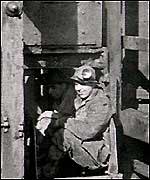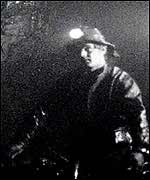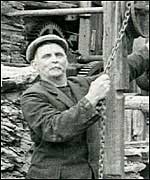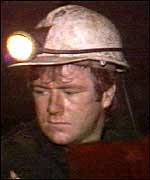|
A Life
Underground
Any job
working below the earth's surface is potentially hazardous and tin mining
in the south west was no different.
 |
|
Bal
maidens were supervised by 'bal cappens' |
In the 18th
and 19th centuries, it was common place for children to be employed at
the tin mines.
In
1839, 7,000 children were employed in Cornish tin mines.
Until the
age of 12, young boys worked largely above ground, breaking up rock as
it was brought to the surface.
Women, known
in the trade as 'Bal Maidens', were also employed to perform similar duties.
Using small
hammers, the women and children would break the ore down to manageable
sizes before loading into trolleys and pushing it to the ore crushing
machine.
Deeper
underground
For the
men who went down into the deep mines, conditions were, hot, oppressive
and very dangerous.
 |
|
Cages
were not a feature of the early mines |
Miners were
responsible for buying their own tools, candles, and dynamite an added
strain on an already meagre wage.
There were
no cages to haul miners up and down the shaft in the early days.
Instead mines were reached by ladders - sometimes stretching down for
100 feet. Not surprisingly, falls were commonplace.
Once at
the rock face, conditions were almost unbearable, temperatures reached
to 60 degrees Celsius.
At South
Crofty Mine in the 1890s men were issued with six candles every day.
Air was in the mine was polluted by dust and fumes from detonated explosives
and could barely sustain a candle.
In fact,
some miners would chose to snub their candles out and work in complete
darkness in order to conserve air.
The Dark
Side
Mike Miucci
was a miner after the Second World War, and remembers the dangers all
too well.
 |
|
The
darkness could be terrifying |
"It's
terrifying because everything's dark...you had to look after yourself,
because in the level it's got holes every twenty feet with boards on top."
"You
had to be careful where you stepped - it was 100 feet deep."
He also
remembers that some men died very young as a result of the conditions.
Mike says
that he can recall "the dust in your lungs. And the pressure, the
depth and the pressure when you blast, your ears when you drill."
"You
lose your ears quick because of the awful noise. We never had any earmuffs
in them days."
Safety
Last
Despite
safety improvements, conditions remained dangerous below ground.
The early ladders were replaced by gigs which transported men down to
the subterranean world. These continued to be used until the 1930s but
were still subject to accidents.
 |
|
Miners
lacked today's safety standards |
The Levant
Mine Disaster of 1919 was one of the worst tragedies with huge loss of
life caused by the collapse of the man engine and the miners' cage.
Maureen
Jolly's father survived the disaster and remembers his horrendous injuries:
"He
had about eight or nine crushed ribs, 38 stitches in his face, he lost
all his teeth and he lost his hearing."
"One
ear was very deaf, he couldn't hear anything... and it was about twelve
months before he could even go to work again," recalls Maureen.
A Short
Fuse
Explosions were another hazard despite new safety
measures introduced in the 20th century.
The earliest fuses had been quills or lengths of straw,
and were very dangerous.
Safety fuses were invented around 1830 and helped to minimise the risk
of unwanted explosions.
The new fuses saved many lives, but misfires could still
be deadly.
The Human
Cost
 |
|
Miners
feared silicosis |
Tin miners
were prone to many different diseases as a result of working in hot, damp
and dusty conditions underground.
Bronchitis,
silicosis, TB and rheumatism were all common complaints for miners, making
life expectancy short.
Few miners in the early days were fit to work beyond the age of 40.
Even in
the late 20th century many tin miners died from silicosis caused by rock
drilling.
Particles
of mica dust punctured the miners' lungs - it was a terrible, wasting
illness.
Anne Elsworth's
father died of silicosis. "When my dad died he had enough lung to
cover a threepenny bit," she recalls.
Hazards
 |
|
Arsenic
workers had little protection from the poisonous by-product of tin |
Rock falls,
flooding and arsenic present in tin and copper mines were other hazards
faced by miners on a daily basis.
Fatalities were a frequent and unsurprising occurrence.
Arsenic
workers had little or no protective clothing, wearing only handkerchiefs
and loose cloth wrapped around their faces.
Miners were prepared to risk life and limb because the pay was reasonably
good down the tin mines.
Former miner
Bob from Wheal Jane Mine recalls his days down the mines: "Wheal
Jane was good pay... they would pay you for the first fortnight, what
they call 'honours time', that's the ordinary wage."
"Then
the end of the month miners would have all their footage. Then they would
get the big pay day."
A Long
Working Week
All miners,
including the women and children on the surface would work a ten hour
day, six days a week in the 19th century.
Although
many miners and their families lived in cottages rented from the mining
company, many would still have to walk several miles to and from work,
in clothes wet with sweat from hours of underground toil.
Life for
a miner was a far cry from the romantic view portrayed in so many of today's
tourist brochures and the success of Cornwall's tin mining industry often
overshadows the human cost.
Even in the 20th century
Cornish tin miners worked long, hard hours, although the pay wasn't bad.
In the early 1980s a tin miner could earn £800
per week if he worked all hours.
But the boom years were over, and by the 1990s Cornish tin mining was
no more. South Crofty was the last mine to close in 1998 - it was the
end of an era.
|

